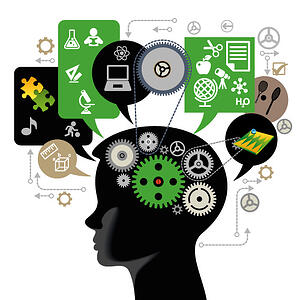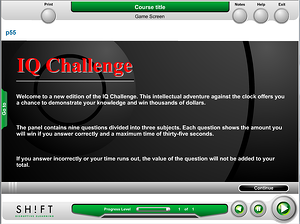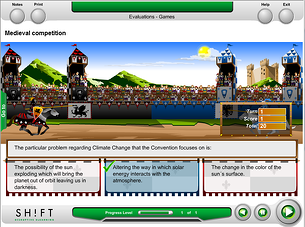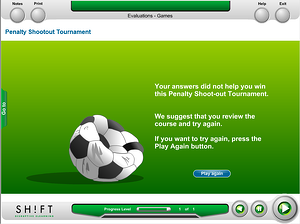It's a common phrase to say "learn by playing." Different communication theories confirm this. Games make us produce dopamine, a brain chemical that increases learning and stimulates our state of attention. eLearning experts believe that games and playing need to be part of a course for adults to learn effectively. As a result, learning games are a necessary part of great eLearning these days. Without them, your courseware wouldn’t be so engaging...“They are fun, competitive, rewarding, interactive, and attention-grabbing. Traditional training is…not any of those” says Steve Boller from Bottom-Line Performance Blog.
 Since the ultimate goal is to get your learners to complete the course and actually learn the content in it, games are a great way to achieve this. Because the design of your game has a direct impact on the learning experience, it's absolutely critical that you approach it wisely. When games are created with the learner in mind, students don’t even realize they’re in a training session.
Since the ultimate goal is to get your learners to complete the course and actually learn the content in it, games are a great way to achieve this. Because the design of your game has a direct impact on the learning experience, it's absolutely critical that you approach it wisely. When games are created with the learner in mind, students don’t even realize they’re in a training session.
Here are the five most critical components of outstanding Learning Games:
Goals and objectives:
Games definitely help reinforce learning objectives through playing. Therefore, it's very important to make sure if the games that are planned to be included are based on your initial objectives. As well, you need to define what the learning objectives for the game should be (knowledge, skills, and attitudes).
Some games turn out to be just boring ordinary games instead of proper ones with good content. On the other hand, there are others that have plenty of information which is unnecessary. You need to ask yourself some questions: What is the learning objective? Is the structure of the game appropriate for the instructional objectives, for the audience’s characteristics and intended use? Remember: students need to see the point of it all and know what they personally will get out of the game.
Note: You can include any number of games you want in a single eLearning course with the only condition that they must respond to initial course objectives.
Rules and/or Instructions:
 This brings us to the next concern that trainers have with regard to including learning games and that is rules and/or instructions. Effective instructions are a vital part when using learning games in your courses. Learners need to know what they are expected to do and how the game is played in order to succeed. You need to answer to some basic questions, for example: Does the game include clear and concise instructions? Do the rules avoid unnecessary and insignificant items?
This brings us to the next concern that trainers have with regard to including learning games and that is rules and/or instructions. Effective instructions are a vital part when using learning games in your courses. Learners need to know what they are expected to do and how the game is played in order to succeed. You need to answer to some basic questions, for example: Does the game include clear and concise instructions? Do the rules avoid unnecessary and insignificant items?
Interaction:
Games are a great resource for experimenting with ideas and knowledge. Without doubt, in games, anything the learner does has a consequence; therefore they become a valuable and experiential tool. It's highly empirial and interactive because students are able to see their results of their decisions in real time, and they can also change their choices and experiment with how they could improve their performance by trying things differently.
There are several different types of games that offer interactivity. Some that we can mention: Adventure games, Building games, Reality Testing games, Role-play games, Puzzles, Competitions, Sport Games. Always keep in mind that you’re making it easy for learners to play the game!
Conflict (and/or competition, challenge, opposition)
 The next -- and probably biggest -- question when including learning games in your courses is, how can they be challenging enough to avoid boredom? This is a tricky question, because games are extremely powerful and students will spend all their energies on winning if they are developed correctly. Therefore, you have to be careful the game is developed with this in mind. For your convenience, SHIFT offers more than 20 different games already developed with this in mind, so you don’t have to spend time thinking on this. A challenging game usually means more learners will be willing to play the game, so you’ll generate more engagement.
The next -- and probably biggest -- question when including learning games in your courses is, how can they be challenging enough to avoid boredom? This is a tricky question, because games are extremely powerful and students will spend all their energies on winning if they are developed correctly. Therefore, you have to be careful the game is developed with this in mind. For your convenience, SHIFT offers more than 20 different games already developed with this in mind, so you don’t have to spend time thinking on this. A challenging game usually means more learners will be willing to play the game, so you’ll generate more engagement.
Keeping in mind that challenge should match the skill level of the student. Providing an adequate challenge is introducing one that it’s not easy to bore students and not too hard to be resolved, the result can an increase in student’s motivation so be careful!
Taking a challenge, achieving better scores every time, experimenting and seeing what happens are some of the aspects you should consider to maintain conflict. The most important thing is that you have enough content to evaluate in a game, so that you can combine different variables to regulate the game’s difficulty level. Although you don’t use games as tests, you should always show students that they are being evaluated and they must respond responsibly. All this is also part of the initial motivation for training.
Outcomes and Feedback
 The last major component of your games is the feedback learner’s receive. Certainly, within games there is a close connection between action and instantaneous feedback. Learners need feedback when asked to respond to the different questions. They need to be able to know how they are doing. Therefore, you need to show them if their answers are correct or incorrect… and explain why (Never just say: “That’s wrong. Try again”). Include feedback continuously as it will increase learning and motivational results. Just make sure that it’s encouraging and that should help to reduce friction for completing the game.
The last major component of your games is the feedback learner’s receive. Certainly, within games there is a close connection between action and instantaneous feedback. Learners need feedback when asked to respond to the different questions. They need to be able to know how they are doing. Therefore, you need to show them if their answers are correct or incorrect… and explain why (Never just say: “That’s wrong. Try again”). Include feedback continuously as it will increase learning and motivational results. Just make sure that it’s encouraging and that should help to reduce friction for completing the game.
You can quickly add several different types of games in your courses with SHIFT:
- Game show competitions: IQ Challenge for example.
- Detective and adventure games: Rescue de princess,
- Timed games: Rally
- Sport games: Baseball, Basketball, Golf and Tennis tournaments for example.
- Simulation games
Dare to use games in your training! They definitely help engage learners and make them think. As well, they are a totally different and fresh way to assess students without falling into monotony.
Master these five crucial components when developing learning games, and you'll significantly improve your eLearning courses.









